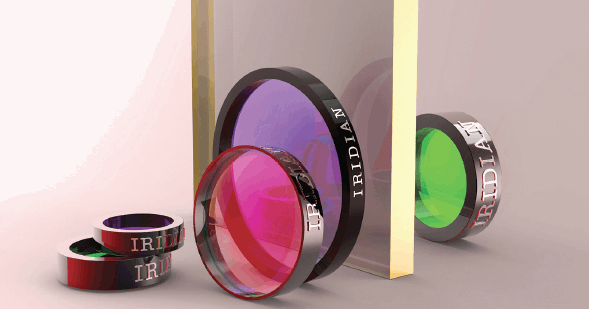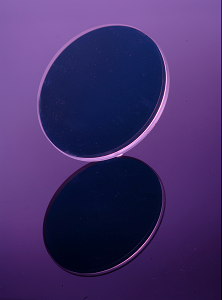In this interview, AZoOptics talks to Jason Palidwar, Product Group Manager at Iridian Spectral Technologies, about infrared imaging and the optical filters Iridian can provide.
Could you provide an overview of Iridian Spectral Technologies and the work you do in the optics field?

Iridian Spectral Technologies has been active since 1998, at the beginning of the telecom boom. The company developed from the work of researchers at the National Research Council of Canada, who were working on optical thin films. Iridian initially worked with optical filters for fiber optic telecom applications, later diversifying while continuing to manufacture telecom filters. These filters currently account for around half of the company’s sales in Asia.
After the telecom bust, the company looked to diversify its capabilities and expand into other market areas. It did this by applying the same coating technologies and energetic magnetron sputtering to new applications, including Raman spectroscopy and fluorescence microscopy. Iridian later became heavily involved in 3D cinema, developing and manufacturing several million pairs of wavelength-selective 3D glasses, currently in use in cinemas and theme parks around the world.
Recent developments and new market areas have included remote sensing, LIDAR, and space-based applications such as satellite communication technology. The same optical coating technology is applicable to all of these different application spaces.
Historically, IR detectors were mostly utilized in the military and defense industry; however, this is changing. What are the current and emerging markets for IR imaging and how is Iridian involved in these?
The primary market for IR sensors and imaging was initially military and defense. This was because of the applications; for example, tracking people and objects invisibly and remotely. This was also because the technology to achieve this was new and expensive, so it was only viable for organizations like the American military that had access to the funds required.
As the technology developed, those technologies became cheaper, more efficient, and easier to commercialize, particularly as the technology was no longer being sold to one large military or defense client. In particular, the price point for detectors plummeted, allowing commercial applications to start making commercial sense. Applications like industrial process control are becoming more common, generally involving an industrial build of components, using a near-IR technology to investigate samples beyond the visible spectrum to see particular characteristics and features.
Some organizations are working in the telecom region at 1550 nanometers, developing technologies for an eye-safe, remote sensing application. Gas detection and other chemical and molecular analysis like proteins, fats, lipids in dairy products are analyzed in the mid and longwave infrared regions, often at 3-5 microns with 8-10 microns used to look at specific molecular components. Environmental monitoring, thermal imaging and secure communications may take advantage of anywhere from the near to the longwave infrared wavelengths.
All of these areas have seen an evolution in technology because of the reduction in cost and the ability to mass-produce the components needed for these systems.
How does Iridian help to conduct multispectral imaging?
NIR imaging, IR sensing, and detection generally necessitate the use of single-channel detection. Applications like non-dispersive infrared detection systems may be used to monitor a single gas line, for example, in order to detect when light reaches a certain level, therefore indicating the presence of a gas. A similar principle is applied when using photoacoustic spectroscopy to examine a single molecular element.
Some applications, for example, Earth observation, benefit from being able to look at multiple different spectral lines simultaneously. In these cases, users are not looking for the presence of a single line of interest. Instead, they need to look at a background spectrum and identify which molecules are present. There are multiple ways of achieving this, including the use of filter wheels or individual components that are spun to facilitate looking at one wavelength after another. However, these methods do not provide a specific snapshot of everything at once, at a specific time.
In contrast, multi-spectral imaging takes a multi-spectral sensing single detector and places a wavelength selective element in front of it, fitted with different spatially varying spectral bands. Different pixels and different detectors on the image will have a wavelength selective optical filter in front of them, meaning that those pixels see a certain spectral phenomenon, whereas other pixels see other spectral phenomena.
Iridian's role is to provide that wavelength selective optical filtering element and these are available in a wide range of wavelengths from the visible field to near IR and even multi-spectral arrays that go from shortwave right into longwave infrared.
We create these multi-spectral arrays, or spatially varying spectral arrays, using two different approaches. We may use a butcher block approach, which involves taking individual single and filter elements, cutting them up into bars, and gluing them together into a butcher block like array. This block is then placed in front of the detector. Alternatively, we may use a patterned approach where we photolithographically mask off areas of a monolithic piece of glass and coat the piece of glass in that zone with a coating, later exposing another part of the substrate and coating that with a different coating. This approach sees us patterning and coating for different spectral regions on a single piece of glass.
There are pros and cons to each approach in terms of the complexity of the filters that can be employed, in terms of the costs, and in terms of coplanarity. One is not better than the other and we adopt both of these approaches, depending on the particular functional needs of the customer's applications.
With respect to IR imaging, what are the main needs to address and challenges to overcome?

IR imaging is wavelength agnostic – it is the same across almost all of our customer's applications. One of Iridian’s core goals is ‘more signal, less background.’ Signal to noise is a key consideration for every application. Achieving better signal to noise is entirely related to providing wavelength selectivity, by achieving high transmission in the bands that users want to see and deep and broad blocking in the bands that they don't want to see. This principle applies equally to the visible, near IR, and longwave infrared regions, with different specifications required in each region.
This issue is equally important in the longwave region, although somewhat different in terms of the source of the signal and the noise. Visible and near IR applications will typically use an illumination source, with light-reflecting back from or fluorescing different phenomena, as well as specular reflectance of that external illumination source. In the longwave infrared region (for example with thermal imaging), users do not see the reflection or absorption of an external light source from an object. Instead, they see the blackbody radiation of the object itself.
In these circumstances, it is important to use a narrow and selective wavelength region so as to only look at the particular phenomena of interest. IR encompasses a broad range of wavelengths from around 700 nanometers to 15 microns, so along the way, a transition will take place from standard materials, both in terms of detectors and filters. In terms of the filter materials that Iridian uses, the transparency and absorption of those materials varies across this broad spectral range.
Different material sets need to be used to address functional needs in different areas, so different optical components must be manufactured. This can pose a challenge, but in applications that use a broad range, it may be possible to use a combination of different materials in the same configuration. Components may be required to operate in a range of potentially extreme environments. They have to be robust and reliable enough to survive in the real world and may need to be manufactured to specifically withstand particular environmental conditions.
Do the requirements for IR imaging filters change depending on whether it is near-infrared, medium wavelength infrared, or longwave infrared that is being utilized?
When dealing with such a broad range, general requirements may not change in the sense that all applications require more signal and less background and most applications require wavelength selectivity. However, the materials that we use do change and these require different material handling approaches and different processing.
In the longwave infrared, for example, we have exclusively employed energetic magnetron sputtering for deposition of our optical filters. Most manufacturers stop sputtering in the short to mid-wave infrared region, but we have expanded the capabilities of this technique to be able to work at about 10 microns. Sputtering is difficult beyond this point, however, because there is too much absorption in the sputtered materials in the long-wave region and in the UV, located at the other end of the spectrum.
To address this, we have added in an evaporative coating technology that will allow us to use different material sets requiring evaporation, pushing the wavelength limit that we can address with our optical filters beyond 10 microns, up to as high as 15 microns. This helps us to access application spaces in thermal imaging and other very longwave infrared spectroscopic applications that make use of that 10-15 micron region.
We have had this particular equipment in house for nearly a year, but it is still being tested by our R&D teams. We envision that in early 2021 we’ll be able to roll this out and start being able to address those specific needs in that extended region.
How does Iridian address these needs and challenges with their IR imaging filters?
Having been in operation since 1998 and dealing with a range of customer bases like telecom has allowed Iridian to develop a wealth of experience in dealing with these challenges. For example, while some telecom components may sit in easily accessible racks, other applications might see that telecom component being sunk to the bottom of the ocean during a submarine cabling application.
In these cases, customers will not want to have to go and pull up and replace this filter in the future, so reliability is key. Iridian’s history of producing high quality, high reliability, highly wavelength-selective filters for applications such as telecom and spectroscopy has allowed us to address these challenges. The company has extended this expertise and experience into more general IR applications, taking that same technology, philosophy, and quality approach into these new areas.
Telecom has always been a large part of Iridian and our optical filters are often shipped to countries like China or Thailand to be manufactured into other components. There is a large cost driver with these types of components, so we have integrated a significant amount of automation into our processing and handling to help reduce costs. We have applied the same approach and automation to our infrared products.
Iridian is particularly well placed to meet these challenges because the applications for our products are extremely broad. While we have specific competitors in telecom, spectroscopy, or space applications, very few, if any, of our competitors are the same across all of these areas.
Our broad range of applications means that we can take learning or advancement from one area and apply it to another and as applications evolve and change, we have knowledge and expertise from dealing with all of these different application spaces and the processing requirements to address them. We do not have a single approach - we have many approaches that we can adopt as needed to meet specific customer requirements.
As we coat a substrate, we monitor the layers and ensure that the deposition is achieving the desired end result. We don't just design a filter and lay that design down - as we are laying the layers down, we measure this using in-house software, reflexively controlling the deposition equipment and making necessary changes to subsequent layers to bring the performance back into specifications where required. This is a core element of manufacturing high performance wavelength selective optical filters and this approach allows for tightly controlled, precise filters, as well as repeatability of manufacture.
Where do you think the future of IR imaging lies?
It is hard to say. Once technologies become available, it is at that point that applications evolve to take advantage of those technologies. That said, the ability to image, sense and detect the invisible is certainly going to be valuable. Whether this is in thermal profiles, gases, or environmental monitoring, mid and longwave infrared have great potential.
The Internet of Things is another key area where we expect to see growth. The IoT sees almost everything around us employing sensors and detectors; for example, a fridge could use a gas detector to detect gases emitted by rotting food. Meanwhile, FLIR - a company in the U.S. - offers a phone attachment for thermal imaging, which can be attached to a regular cell phone camera.
There are many real-world applications in agriculture where IR imaging has potential. We know that insects can be seen in certain wavelength regions, so we could use UV or infrared to look at pollination paths on flowers, determine how ripe fruit is, or remote sensing could be used to evaluate the effectiveness of pest treatment on crops.
All of these applications can be facilitated by expanding the wavelength region over which we can look. There’s a common phrase that says, ‘you cannot manage what you do not measure,’ and the ability to measure over a broader spectral region allows us to see more things, manage more things, better control, and interact more meaningfully with our environment.
About Jason Palidwar
Jason joined Iridian in 2006 and has over 20 years of experience working with thin-film optical filters. He has developed filter specifications together with Iridian’s customers to optimize solutions for a wide range of technical and commercial needs in applications such as telecom, Raman spectroscopy, fluorescence microscopy, 3D entertainment, and IR remote sensing. Recently, as Product Group Manager of Aerospace and Specialty Optics, his focus has been on optical filters for use in satcom (optical inter-satellite link filters and solar rejection windows) and earth observation including multispectral filter arrays. Jason has an MSc in Physics from McMaster University.

Disclaimer: The views expressed here are those of the interviewee and do not necessarily represent the views of AZoM.com Limited (T/A) AZoNetwork, the owner and operator of this website. This disclaimer forms part of the Terms and Conditions of use of this website.